The article shows how to create an Excel drop down that allows users to select multiple items with or without duplicates.
Excel has come a long way since its inception and introduces more and more useful features with each new release. In Excel 365, they've added the ability to search within data validation lists, which is a huge time-saver when working with large sets of data. However, even with this new option, out-of-the-box Excel still only allows selecting one item from a predefined list of options. But fear not, as there is a solution. By using VBA, you can create drop-down lists with multiple selections. With the ability to prevent duplicates and remove incorrect items, this feature can streamline data input and improve accuracy in your Excel spreadsheets.
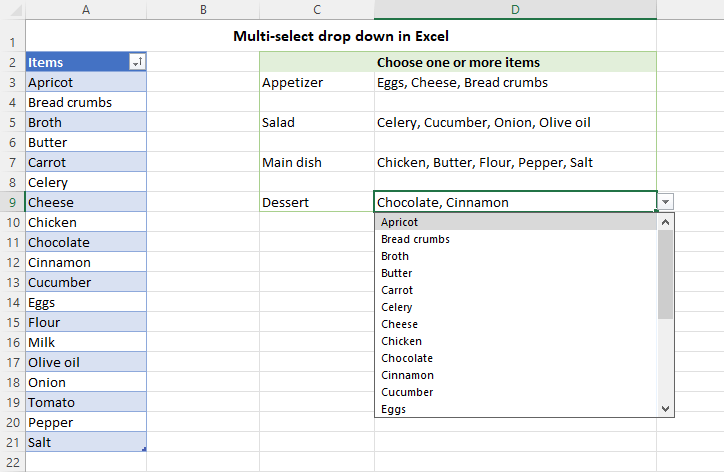
How to make Excel drop down with multiple selections
Creating a multi-select drop down list in Excel is a two-part process:
- First, you make a regular data validation list in one or more cells.
- And then, insert the VBA code at the back end of the target worksheet.
It also works in the reverse order :)
Create a normal drop-down list
To insert a drop down list in Excel, you use the Data Validation feature. The steps slightly vary depending on whether the source items are in a regular range, named range, or an Excel table.
From my experience, the best option is to create a data validation list from a table. As Excel tables are dynamic by nature, a related dropdown will expand or contract automatically as you add or remove items to/from the table.
For this example, we are going to use the table with the plain name Table1, which resides in A2:A25 in the screenshot below. To make a picklist from this table, the steps are:
- Select one or more cells for your dropdown (D3:D7 in our case).
- On the Data tab, in the Data Tools group, click Data Validation.
- In the Allow drop-down box, select List.
- In the Source box, enter the formula that indirectly refers to Table1's column named Items.
=INDIRECT("Table1[Items]")
- When done, click OK.
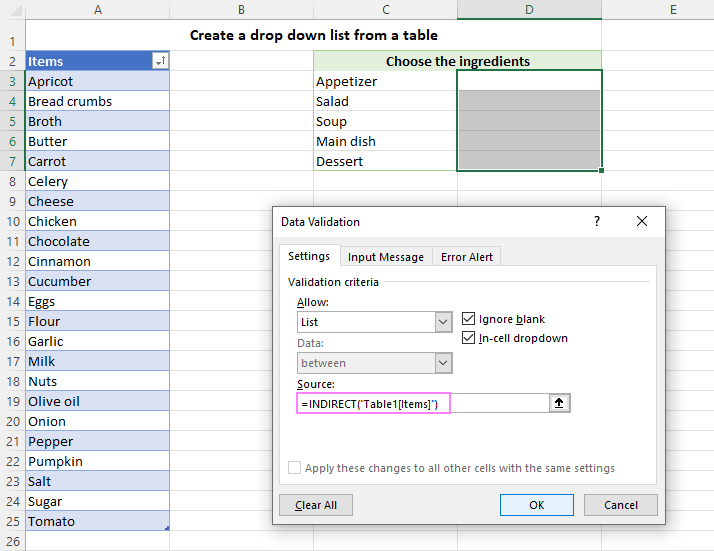
The result will be an expandable and automatically updatable drop-down list that only allows selecting one item.
Tip. If the method described above is not suitable for you for some reason, you can create a dropdown from a regular range or named range. The detailed instructions are here: How to create Excel data validation list.
Insert VBA code to allow multiple selections
This is the core part of the process that does the magic. To turn a regular single-selection picklist into a multi-select dropdown, you need to insert one of these codes in the back end of your target worksheet:
- VBA code for multi-select drop down with duplicates
- VBA code for multi-select drop down without duplicates
- VBA code for multi-selection dropdown with item removal
To add VBA code to your worksheet, follow these steps:
- Open the Visual Basic Editor by pressing Alt + F11 or clicking the Developer tab > Visual Basic. If you don't have this tab on your Excel ribbon, see how to add Developer tab.
- In the Project Explorer pane at the left, double-click on the name of the worksheet that contains your drop-down list. This will open the Code window for that sheet.
Or you can right-click the sheet's tab and choose View Code from the context menu. This will open the Code window for a given sheet straight away.
- In the Code window, paste the VBA code.
- Close the VB Editor and save your file as a Macro-Enabled Workbook (.xlsm).
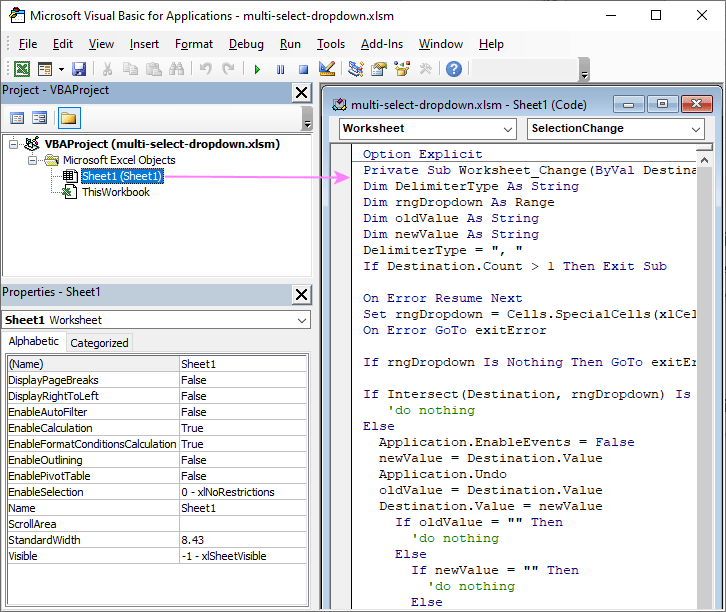
That's it! When you go back to the worksheet, your drop-down list will allow you to select multiple items:
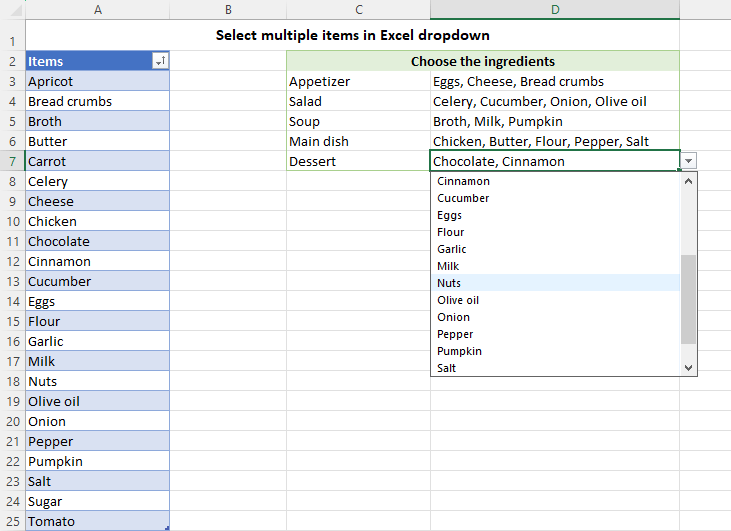
VBA code to select multiple items in dropdown list
Below is the code to make a data validation list that allows selecting multiple items, including repeated selections:
How this code works:
- The code enables multiple selections in all drop down lists on a particular sheet. You do not need to specify the target cell or range reference in the code.
- The code is worksheet specific, so be sure to add it to each sheet where you want to allow multiple selections in drop down lists.
- This code allows repetition, i.e. selecting the same item several times.
- The selected items are separated with a comma and a space. To change the delimiter, replace ", " with the character you want in DelimiterType = ", " (line 7 in the code above).
Note. The same character cannot be used as both the delimiter and part of the dropdown items. In our code, the default delimiter is a comma followed by a space (", "), so this combination of characters should not appear anywhere within the dropdown items themselves to avoid conflicts. If you change the delimiter to a single space (" "), bear in mind that the code will only function correctly for single-word items, failing to handle multi-word items containing spaces.
Excel multi-select dropdown without duplicates
When selecting from a large list, users can sometimes pick the same item more than once without noticing. The code below solves the problem of duplicates in a multi-selection data validation drop down list. It lets users pick a particular item only once. If you try to select the same item again, nothing will happen. Pretty cool, right?
Multi-selection dropdown with item removal
When users need to select multiple options but can make mistakes or change their minds during the selection process, a multi selection dropdown that allows for the removal of incorrect items can be a lifesaver.
Consider a scenario where you need to assign multiple tasks to team members using a drop-down list. With Excel's default functionality, the only way to remove an incorrectly assigned task is by clearing the entire contents of the cell and starting over. With the ability to remove individual items from the selection, the team can effortlessly modify task assignments without confusion or errors.
The code below implements the item removal functionality in a simple and intuitive way: the first click on an item adds it to the selection, and a second click on the same item removes it from the selection.
The below demo highlights how the multi selection dropdown with removal functionality works in Excel. The users can select multiple options from the data validation list and make adjustments on the fly. A streamlined and effective approach to managing selections!
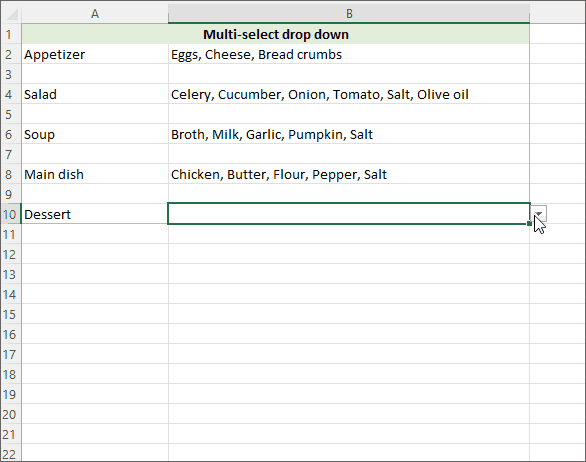
How to make a multiple selection dropdown with custom delimiter
The character that separates items in the selection is set in the DelimiterType parameter. In all the codes, the default value of this parameter is ", " (a comma and a space) and it is located in line 7. To use a different separator, you can replace ", " with the desired character. For instance:
- To separate the selected items with a space, use DelimiterType = " ".
- To separate with a semicolon, use DelimiterType = "; " or DelimiterType = ";" (with or without a space, respectively).
- To separate with a vertical bar, use DelimiterType = " | ".
For example, if you change the delimiter to a vertical slash, your multi-select picklist will look as follows:
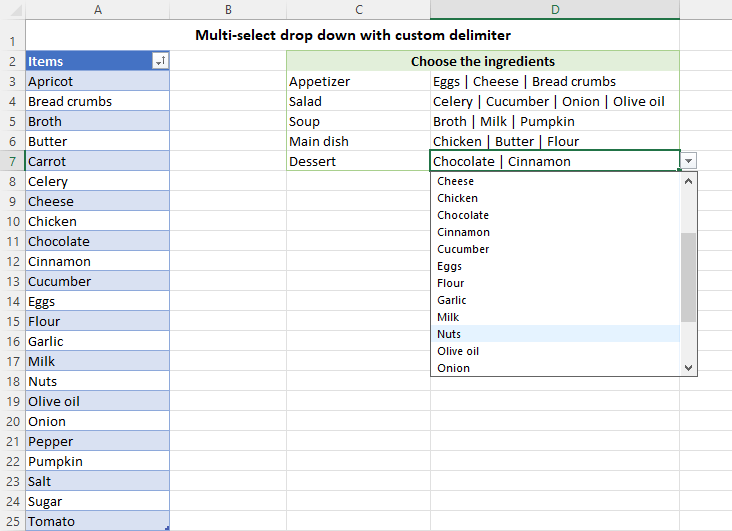
How to create dropdown with multiple selections in separate lines
To get each selection in a separate line in the same cell, set DelimiterType to Vbcrlf. In VBA, it is a constant for the carriage return and line feed characters.
More precisely, you change this code line:
DelimiterType = ","
to this one:
DelimiterType = vbCrLf
As a result, each item that you select from the dropdown list will appear in a new line:
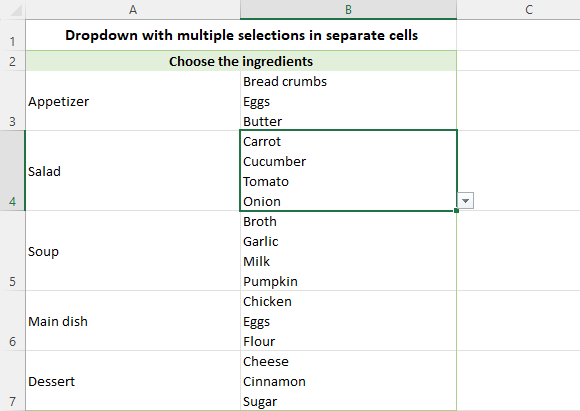
How to create multi-select dropdown for specific columns, rows, cells and ranges
All the codes described in this tutorial work across an entire sheet. However, you can easily modify any of the codes, so it only applies to specific cells, rows, or columns as needed. For this, find this line of code:
If rngDropdown Is Nothing Then GoTo exitError
Add immediately after it, add a new line specifying where to allow multiple selections, as explained in the below examples.
Multi-select drop-down for specific columns
To allow selecting multiple items in a certain column, add this code:
If Not Destination.Column = 4 Then GoTo exitError
Where "4" is the number of the target column. In this case, the multi-select dropdown will be only enabled in column D. In all other columns, dropdown lists will be limited to a single selection.
To target several columns, specify their numbers using this code:
If Destination.Column <> 4 And Destination.Column <> 6 Then GoTo exitError
In this case, the multi-select dropdown will be available in columns D (4) and F (6).
Multi-selection dropdown for certain rows
To insert multiple drop-downs in a specific row, use this code:
If Not Destination.Row = 3 Then GoTo exitError
In this example, replace "3" with the row number where you want to enable multi-select dropdowns.
To target multiple rows, the code is as follows:
If Destination.Row <> 3 And Destination.Row <> 5 Then GoTo exitError
Where "3" and "5" are the rows where selecting multiple items is allowed.
Multiple selections in specific cells
To enable multiple selections in particular cells, add one of the below code lines.
For a single cell:
If Not Destination.Address = "$D$3" Then GoTo exitError
For multiple cells:
If Destination.Address <> "$D$3" And Destination.Address <> "$F$6" Then GoTo exitError
Just remember to replace "$D$3" and "$F$6" with the addresses of your target cells.
Multi-select drop-down for specific range
To limit your multi-select dropdown to a particular range, replace this line of code:
If Intersect(Destination, rngDropdown) Is Nothing Then
with this one:
If Intersect(ActiveCell, Range("C3:D10")) Is Nothing Or Intersect(Destination, rngDropdown) Is Nothing Then
The range of interest is specified directly in the code (C3:D10 in the above example). This modification offers a more efficient approach to handing ranges - instead of individually listing 16 cells, you use a single range reference.
How to enable multi-selection functionality in protected sheet
To enable a multi-select dropdown functionality in a protected worksheet, simply insert the following code into the sheet where you've added the primary code. This "protected sheet" code should be added after the main code.
Before adding this code to your worksheet, remember to replace "password" with the actual password you used to protect the sheet. And this is the only change that needs to be made. The code will automatically detect the presence of a dropdown list in a given cell and allow editing of that cell. In all other cells, editing will remain restricted.
Note. Please be aware that including your real password in the code could lead to a security risk. To ensure the safety of your workbook, store it in a secure location that is protected against unauthorized access or use.
So, there you have it - an Excel dropdown list with multiple selections. Adding this awesome feature to your spreadsheets will increase the accuracy of your data input and help you get your work done faster!
Practice workbook for download
Multi-selection dropdown - examples (.xlsm file)
 by
by
548 comments
Hey, any tips for getting this to work in a shared sheet? For other people?
Hi! We've already noted many times in this article and in the comments that VBA doesn't work in Excel Online and that running macros is impossible.
Hi, each time I try to run the code on VBA, it tells me to input macro name and I am not sure what to insert in the macro name dropbox. AI said the code isnt a macro script
I was getting the same thing, and it was frustrating. Then I double clicked on the worksheet I wanted the multiple selection function in the VBA editor and pasted the code into that window instead of "inserting a module". That seemed to do the trick.
Hey Alex - thanks so much for this. I was just hoping to ask if it was possible when trying to filter the options subsequently if the drop down options can remain separate? For example using your options if butter was in multiple courses but I was hoping to see which courses it was used in?
Thanks for your help again.
Hello Jonathan!
Drop-down list creates text string in cell. You can filter data by portion of this text string using the Filter tool or the FILTER function.
Thanks for this. For the multi-select drop-down for several specific columns, is there a way where I can use different delimiter for each column? For example, I'd like to use comma on column 4 and semicolon on column 6.
Hi! In an Excel worksheet, you can use only one code that determines the changes in the values in drop-down list. To use different word separators in the drop-down list for different columns, you'll need to make significant code changes. Your request goes beyond the advice we provide on this blog, and you can try it yourself.
OMG Thank you! I spent so much time trying to get AI to generate the code I needed to make a multi selection drop down in excel today, to no avail, nothing it gave me worked. So I asked Google, got here immediately and now my spreadsheet works, it looks even better than planned with the extra tips for formatting you provided. Thank you so much for sharing this.
hi , thanks for solving one of my problem with the code... it works great... but it doesn't work if the worksheet is protected even after using the said code for the password.....
Hi! I can't see your workbook, but this situation is described in detail in the article above.
I'm using the code that lets you unselect the selection and it works perfectly, except my list is numbers, some of which have leading zeros.
In File > Options > Data I removed the check from "Remove leading zeros and convert to a number". Now it removes the leading zero from only the first selection, but keeps for the rest. If I pick 0341 it shows as 341, but if I select 0341 again it adds as 0341.
How do I keep the leading zero for the first selection?
Hello Susanna!
To prevent text from being converted to a number, set cell format to Text in the cell with the drop-down list.
The code does not appear to work with the data val referencing to a list using indirect to a table. I set this up using the table and the VBA code and just get no response when clicking the dropdown for selecting from the data val list. However, if I use the data val to a named range it works fine.
Hello Sean!
In the example file linked to at the end of the article, the drop-down list is created using INDIRECT with this method: Create drop-down from Excel table.
Hello,
I copied everything as is, but when i try to select multiple entries by selecting the first option then pressing , it just over-writes it and not allowing a second or third option to be selected. What am i doing wrong?
Hello Michael! Check that you copied the code into your workbook correctly. The article above describes all the steps in detail and provides recommendations for troubleshooting. Suggestions are also available in the comments above. You can download a sample file from the link at the end of the article. Also, check that macros are enabled. This may help: How to enable and disable macros in Excel.
Hi, thank you for the article. But, is there a way to do this on multiple columns with Ablebits instead of running the VBA code?
Hi! Unfortunately, the ability to make multiple selections in drop-down list is currently not available in Ablebits Ultimate Suite for Microsoft Excel.
Hello, With the "Multi-selection dropdown with item removal code" with "multiple selections in separate lines" would I be able to change/alter the code to allow for DUPLICATES within those dropdowns? Thanks!
Hi! We do not do VBA code creation or customization on request. You can try to change the code yourself.
Hi Alexander,
Many thanks for your easy-to-follow tutorial.
Is there a way to re-sort the selections alphabetically? Currently, it displays in the order in which they're selected. I.e., if I select "Bread" then "Apple" it displays as Bread, Apple. If it could automatically re-sort, it would result in less permutations in the column filter.
Kind regards,
Rhys.
Hi! You can sort a text string in a drop-down list using VBA code. If you want to sort words in another cell, you can try splitting the words using TEXTSPLIT function, then sorting the words using SORT function, and then joining the words back into a text string using TEXTJOIN function.
=TEXTJOIN(",",TRUE,SORT(TEXTSPLIT(A1,,","),1,1))
Hi - thank you for this - I believe I've got it working but is there a way to have the lookup list on a different sheet? I don't need the sheet to be password protected but just trying to keep the lookup list separate from the main sheet where the users will select the values?
Hi! You can place your drop-down list on a different sheet using these instructions: Add dropdown list from another worksheet. Then add the VBA code for multiple selections to this sheet.
Spreadsheet warrior here. This article is great, works like a charm (bookmarked). But I'm trying to create a dropdown in which I select dollar amounts from a list of expenses that then sums those amounts (rather than just list them separated by commas). It may sound cumbersome, but I want to easily be able to change a single month in a multi-year monthly-expenses spreadsheet table without having to waste time rewriting individual cell formulae every time and possibly make a mistake.
Hi! Unfortunately I don't really understand what you want to do. However, a multiple selection dropdown list can only create a text string, but cannot sum any numbers.
Drop down with multiple selections in separate cells with the ability to edit quantity
How can I edit multiple entries' quantities for each drop-down in one cell
example
Carrots 4 Cucumbers 1 Tomato 8 Onions 1
Hi! In the multiple selection drop-down list, you can select not only words but also numbers from the list. However, you cannot count the number of identical words. For this purpose you need to create a separate macro.
Hi there,
The code works perfectly! Is there a way to now only view certain things selected in the drop down? Say for example - using yours above - only display the dishes that include butter? Or Butter AND chocolate?
Hi! If I understand your question correctly, you can split the text string that you created using multiple selection drop-down list into separate words. To do this, you can use this instruction: Split string by delimiter or pattern, separate text and numbers. Or use TEXTSPLIT function.
Then create a dependent drop-down list based on these separate words. You can try using this guide: Create a multiple dependent drop down list.
Hi Alexander,
Thank you so much for your post. Your Multi-Select Dropdown script works extremely well, unlike others I've tried that fail when more data is added. However, when I select multiple items, I get a "Value must match one of the listed items" error—likely due to the Data Validation expecting only one value per cell. Everything functions otherwise, but is there a way to prevent this error, perhaps by adjusting validation settings?
Hello Neal!
You cannot add or delete multiple items at once. Select items one at a time.
For Multi-select drop-down for specific columns, can I add more than 3 column, what the code
I love the code and it works flawlessly...
When I open it in the desktop version. When i try to use it online the code doesn't work.
Hi! This question has been asked many times before, as you can see from the comments below. Excel Online does not support Visual Basic for Applications (VBA) or VBA macros.
When trying to use your code Multi-selection dropdown with item removal, I receive an error when trying to select my first item from the list. It says, "Compile error: Can't find project or library." The code without item removal works fine within the same sheet.
Hello David!
Carefully copy the code, following all instructions above. You can also download sample file, the link to which is at the end of the article. All codes in this file work correctly.